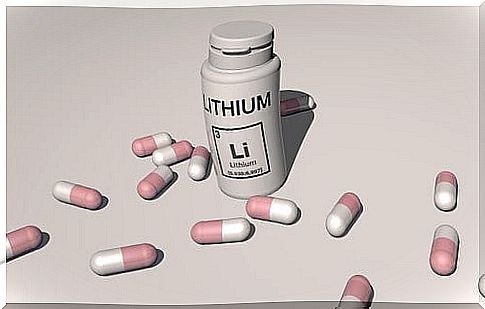Lithium As A Mood Stabilizer

Lithium is an ion: a simple chemical element from the group of alkali metals. It is the lightest solid element of all. It is present in many minerals, sea water, springs, plant and animal tissues, etc.
It was discovered in 1817 and has been used to treat different human conditions, such as gout or psychiatric diseases. For a long time it was responsible for many serious poisonings when used as a substitute for other cations in heart disease.
What is it for?
In Spain, lithium carbonate is currently marketed as Plenur. It is used as a mood stabilizer or stabilizer. It is indicated for:
- Prophylaxis of bipolar disorders.
- Treatment of bipolar disorders.
- Recurrent major depression.
It is the treatment of choice in bipolar disorder or manic-depressive psychosis. This disease alternates episodes of euphoria and extreme exaltation with states of depression and dejection that can lead to suicide.
When a manic episode has occurred, there is a 90% chance of having another episode the same or suffering a depressive episode. For this reason, treatment during the episode is considered as important as prophylaxis when the disease is controlled.
It is also used in patients with recurrent major depression. That is, in those who do not show improvement with conventional antidepressants or only respond partially. On the other hand, lithium chloride is marketed as an injectable solution for diagnostic use to be used in the in vivo determination of cardiac output.

Mechanism of action
Despite its wide use and proven efficacy, the exact mechanism of action of lithium is not known. Further research is necessary.
This ion is rapidly and completely absorbed after oral administration. It is distributed throughout the body and does not bind to plasma proteins. It has a small volume of distribution and is excreted in the urine without metabolism. It can be removed by dialysis.
Being a monovalent cation, it competes with other ions such as sodium in various places in the body; in the Central Nervous System (CNS) it seems to inhibit depolarization caused by neurotransmitters:
- One hypothesis is that lithium lowers cyclic AMP concentrations. Thus, the sensitivity of the hormone-sensitive adecylcyclase receptors would decrease.
- Another hypothesis says that lithium interferes with the lipid metabolism of inositol, an important product in the regulation of metabolic processes in the CNS.
Side effects
Lithium is a drug with a narrow therapeutic margin. That is, the therapeutic dose and the toxic dose are very close. This implies that the appearance of side effects is frequent, so it is important to assess each case and adjust the dose for each patient.
Mainly, adverse reactions of the CNS, gastrointestinal and renal can occur. During the first days of treatment there is usually slight tremor of the hands, thirst, polyuria, nausea and general malaise. These symptoms should decrease during the first 10-15 days.
The most common side effects are:
- Drowsiness.
- Tiredness.
- Muscular weakness.
- Headache
- Confusion.
- Polyuria.
- Polydipsia.
- Hypercalcemia
- Anorexy.
- Sickness.
- Vomiting
- Diarrhea.
- Abdominal pain.
- Constipation.
- Hypothyroidism
- Goiter
In patients treated with lithium, clinical follow-up and blood drug levels must be monitored. The thyroid and kidney functions must be especially controlled. It is recommended to ingest an adequate amount of fluids during treatment and to avoid situations of possible dehydration.

Lithium poisoning
Lithium poisoning can be a common and serious complication if the proper measures are not taken. Acute poisoning can occur from a high dose or chronic toxicity from a continuous treatment of several years. The latter is more common.
Also the interaction with other medications can cause an alteration in lithium levels that can become toxic. For example, some diuretics, anti-inflammatories or even antipsychotics have an influence.
The first manifestations usually appear from two hours after ingestion. Nausea, vomiting, or diarrhea may occur. Cardiovascular syncope, kidney failure, peripheral neuropathy, etc. can also occur. The most important symptoms of lithium poisoning occur at the CNS level :
- Altered consciousness
- Fatigue
- Apathy
- Disorientation
- Hallucinations
In conclusion, we are talking about a fairly effective drug but one that we have to handle with care. In the event of any significant adverse effect, a specialist should be consulted immediately. He is the one who can decide to interrupt the treatment, adjust the dose or propose other alternatives.









